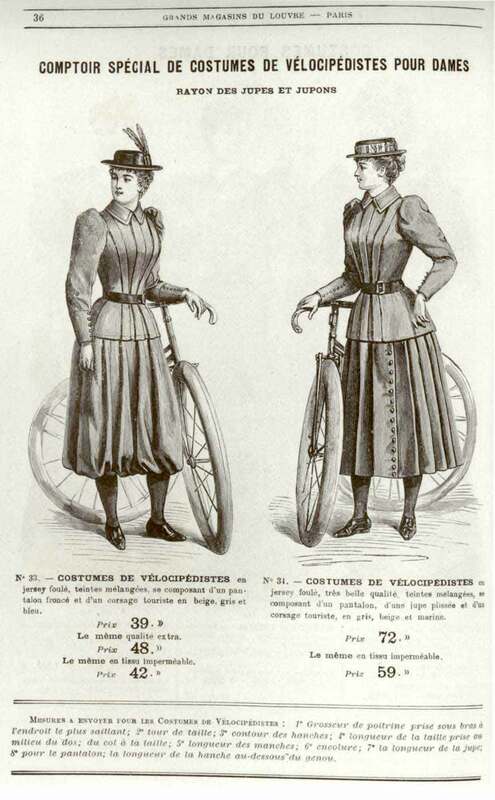Getting around
“Any woman who reveals herself is a disgrace”, wrote Rousseau to d'Alembert. All the more so for she who travels! “Women’s movements and whereabouts, particularly that of single women were viewed with suspicion”, wrote historian Michelle Perrot. However, more and more women were beginning to travel, especially after 1850, when new means of transport made it easier to get around. The colonies also had adventure in store for them.
At the end of the 19th century, a new female culture legitimised travel and its educational vocation for young middle-class women, excluding exploratory and adventurous journeys. Unconventional were the likes of Jane Dieulafoy, Alexandra David-Néel and Isabelle Eberhardt, who satisfied their desire for the Orient.
Women were also noticed on short journeys. Postcards from the 1900s depict women drivers, coachwomen and chauffeurs in their work clothes... But more so than the car, the bicycle, which became widely available at the end of the 19th century, masculinised women’s clothing.
Wealthy women were also keen on sports that were considered masculine: mountaineering, fencing, skating, yachting, canoeing, golf, tennis, cycling, horse-riding... Compromise in dress was of the essence.
Adventure and travel
Cross-dressing was tolerated if it was an occasional disguise designed to protect a woman in public. Women travellers often resorted to it. Among the most famous, Jane Dieulafoy (1851- 1916), Alexandra David-Néel (1868-1969), Isabelle Eberhardt (1877-1904).
In Persia
Born into the Toulouse bourgeoisie, Jane was the “tomboy” of a family of 5 girls. At the age of 19, she married Marcel Dieulafoy, a young École Polytechnique student, fascinated by the Orient. They would have no children.
In 1870, while her husband was a captain, she served as a sniper in the Loire army, donning the men’s uniform. In Persia, where she and her husband’s team discovered the frieze of lions and archers in Darius’s guard, she continued to dress as a man.
When she returned to Paris in 1886, she never removed her “impeccably fine cut linen trousers, a white percale shirt with a thin leather cord to tie around the collar”. She then became a journalist and writer, publishing historical and then psychological novels which revealed her conservative views. One of her books, however, is devoted to the history of cross-dressers...
In Tibet
From an early age, Alexandra David-Néel was fiercely independent and irresistibly drawn to travel, discovery and mystical and philosophical reading. A traveller and explorer, she was fascinated by the Himalayas, where she spent many years. She crossed Tibet on foot, as a pilgrim beggar, dressed in an aurora robe, the colour of detachment, a garnet robe, in Tibet, and also rags, her beggar’s disguise. She even managed to live for two months in the holy and forbidden city of Lhasa. The “woman with soles made of wind” established herself as a respected Orientalist. At the age of one hundred and a half, she had her passport renewed, still eager to set off again.
In the Maghreb
Isabelle Eberhardt could have not discovered the desert without dressing as a male Arab horseman. Her taste for cross-dressing predated her departure for the Maghreb; a photo shows her as an adolescent in Geneva dressed as a sailor. A man’s dress often protects secret wounds (rape through incest, in particular). At the age of twenty, she left her family of Russian aristocrats exiled in Switzerland for the other side of the Mediterranean. She adopted a male identity (Mahmoud Saadi), converted to Islam and married Slimène Ehni. She met Liautey, who marvelled at her “refractory” character, explored the Algerian-Tunisian borders, wrote articles and stories about her discoveries and died at the age of 27, drowned in the flooding of a wadi.
Sportswomen
Costumes were not a minor issue when it came to women's access to sport. Pierre de Coubertin fiercely criticised the practice for women, considering it an inappropriate “exhibition”. Journalists showed curiosity about the changes taking place.
During the Belle Epoque in the women’s press, mainly in Fémina, only 11% of the “sportives” portrayed wore trousers, bloomers or shorts. 14% dared to wear short dresses or skirts (i.e., knee-length). The vast majority wore ankle-length dresses. The very tight ban on trousers was first lifted by fencers in 1905, then by mountaineers in 1906.
Women’s sportswear inspired fashion in the 1920s, and these tennis, bathing and winter sports costumes, were themselves constantly evolving. The feminine-masculine compromise found for tennis, for example, was adopted. On the other hand, the development of women’s athletics and football in the 1920s, which required shorts, provoked some unfriendly comments.
| Reforming | Getting around | Creating (yourself) |



